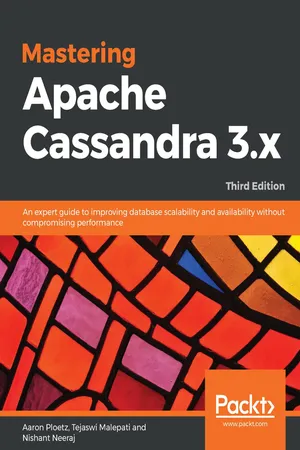
Mastering Apache Cassandra 3.x
An expert guide to improving database scalability and availability without compromising performance, 3rd Edition
Aaron Ploetz, Tejaswi Malepati, Nishant Neeraj
- 348 pages
- English
- ePUB (mobile friendly)
- Available on iOS & Android
Mastering Apache Cassandra 3.x
An expert guide to improving database scalability and availability without compromising performance, 3rd Edition
Aaron Ploetz, Tejaswi Malepati, Nishant Neeraj
About This Book
Build, manage, and configure high-performing, reliable NoSQL database for your applications with Cassandra
Key Features
- Write programs more efficiently using Cassandra's features with the help of examples
- Configure Cassandra and fine-tune its parameters depending on your needs
- Integrate Cassandra database with Apache Spark and build strong data analytics pipeline
Book Description
With ever-increasing rates of data creation, the demand for storing data fast and reliably becomes a need. Apache Cassandra is the perfect choice for building fault-tolerant and scalable databases. Mastering Apache Cassandra 3.x teaches you how to build and architect your clusters, configure and work with your nodes, and program in a high-throughput environment, helping you understand the power of Cassandra as per the new features.
Once you've covered a brief recap of the basics, you'll move on to deploying and monitoring a production setup and optimizing and integrating it with other software. You'll work with the advanced features of CQL and the new storage engine in order to understand how they function on the server-side. You'll explore the integration and interaction of Cassandra components, followed by discovering features such as token allocation algorithm, CQL3, vnodes, lightweight transactions, and data modelling in detail. Last but not least you will get to grips with Apache Spark.
By the end of this book, you'll be able to analyse big data, and build and manage high-performance databases for your application.
What you will learn
- Write programs more efficiently using Cassandra's features more efficiently
- Exploit the given infrastructure, improve performance, and tweak the Java Virtual Machine (JVM)
- Use CQL3 in your application in order to simplify working with Cassandra
- Configure Cassandra and fine-tune its parameters depending on your needs
- Set up a cluster and learn how to scale it
- Monitor a Cassandra cluster in different ways
- Use Apache Spark and other big data processing tools
Who this book is for
Mastering Apache Cassandra 3.x is for you if you are a big data administrator, database administrator, architect, or developer who wants to build a high-performing, scalable, and fault-tolerant database. Prior knowledge of core concepts of databases is required.
Frequently asked questions
Information
Effective CQL
- The evolution of CQL and the role it plays in the Apache Cassandra universe
- How data is structured and modeled effectively for Apache Cassandra
- How to build primary keys that facilitate high-performing data models at scale
- How CQL differs from SQL
- CQL syntax and how to solve different types of problems using it
An overview of Cassandra data modeling
CREATE KEYSPACE packt_ch3 WITH replication =
{'class': 'NetworkTopologyStrategy', 'ClockworkAngels':'1'};
CREATE TABLE playlist (
band TEXT,
album TEXT,
song TEXT,
running_time TEXT,
year INT,
PRIMARY KEY (band,album,song));
INSERT INTO playlist (band,album,song,running_time,year)
VALUES ('Rush','Moving Pictures','Limelight','4:20',1981);
INSERT INTO playlist (band,album,song,running_time,year)
VALUES ('Rush','Moving Pictures','Tom Sawyer','4:34',1981);
INSERT INTO playlist (band,album,song,running_time,year)
VALUES ('Rush','Moving Pictures','Red Barchetta','6:10',1981);
INSERT INTO playlist (band,album,song,running_time,year)
VALUES ('Rush','2112','2112','20:34',1976);
INSERT INTO playlist (band,album,song,running_time,year)
VALUES ('Rush','Clockwork Angels','Seven Cities of Gold','6:32',2012);
INSERT INTO playlist (band,album,song,running_time,year)
VALUES ('Coheed and Cambria','Burning Star IV','Welcome Home','6:15',2006);
Cassandra storage model for early versions up to 2.2

Cassandra storage model for versions 3.0 and beyond
